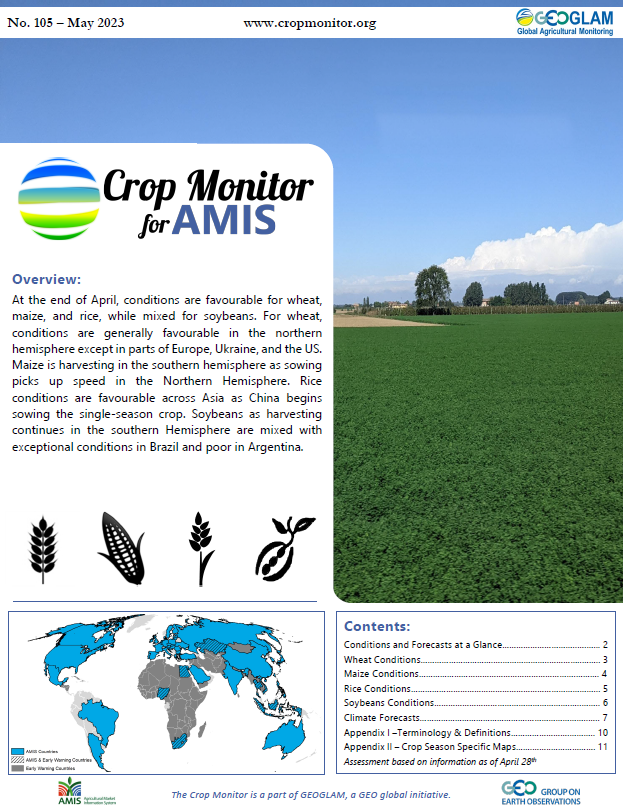About the Reports
Crop Monitor Reports
The Crop Monitor for AMIS, Crop Monitor for Early Warning, and Global Crop Monitor reports are created under a common methodology and share a similar structure. The monthly reports are issued with the support of the respective partners, which contribute to them and reflect a consensus of the community of practice with regard to the conditions and drivers in the area of interest.
The reports consist of several key components: text, maps, pie charts, and climate outlooks. Text provides brief overviews of the conditions of the observed crops, stratified by crop (AMIS) or region (Early Warning). Maps provide a spatially explicit indication of crop condition and the drivers of crop conditions, masked by the average planted area of the respective crop or croplands. A synthesis map indicates the condition of all crops in one map, while individual crop maps provide conditions with respect to individual crops and planting seasons. Pie charts indicate the crop conditions globally (AMIS) or regionally (Early Warning) with respect to individual crop production. For more information on the maps and pie charts, please see the graphical products page. Additionally, the reports contain global and regional climatic outlooks that examine forecast conditions and how those relate to on the ground conditions.
Special Reports
In addition to monthly Crop Monitor reports, in-depth mid-month Special Reports are published by the Crop Monitor community in response to developing situations that may impact crop conditions, rapidly changing conditions on the ground, or new climatic outlooks that provide key insight on an upcoming cropping season. Special reports go in-depth on current conditions providing additional analysis and updates to what is included in the full monthly report including remote sensing analysis and products, updated forecasts, field reports, and market and price analysis where available.
Crop Monitor Special reports were developed in response to a request from UN OCHA in February 2018 during the early season drought in Southern Africa affecting the 2017/2018 main cropping season. The request was for the continuation and doubling down of in-season monitoring efforts as provided by the Crop Monitor and for the provision of more detailed and frequent assessments at key parts of the season and in the face of developing situations. Since February 2019, the CM community has initiated the Special Reports as a mechanism to respond to developing cropping concerns and provide early warning and analysis to decision-makers.
Conflict Reports
War and conflict are among the leading causes of world hunger and can have disastrous impacts on the affected regions’ agricultural production and food security. Common regional impacts of conflict on agricultural production include but are not limited to the following occurrences:
Mass displacement and loss of livelihoods
Destruction and abandonment of fields
Presence of unexploded ordinances on agricultural land
Limited access to agricultural inputs (e.g. seed and fertilizer) and migrant labour
Depreciation and increased costs of agricultural inputs (e.g. seed and fertilizer) and fuel
Destruction of productive assets, irrigation infrastructure, and transportation routes
Competition for limited resources
Direct restrictions to crop types and field locations
Risk-averting behaviours that prevent farmers from fully engaging in agricultural activities
Decrease in livestock and pastureland productivity
As part of the Crop Monitor reporting, conflict is a driver of other-than-favourable crop conditions when armed conflict or civil unrest inhibits field access or interferes with agricultural activities such as farmers' planting, working, and harvesting of the fields. However, the context and extent of conflict are unique to each region and thus, each one has distinctive impacts that go beyond what can be demonstrated in the regular monthly Crop Monitor reports. Therefore, the Food Security & Conflict Reports aim to provide further insight into each region’s specific conflict situation by detailing the history of the current conflict, the agricultural baseline (e.g. information regarding productive zones, land use, primary crops, and climatic trends), and specific impacts of conflict on agricultural production and food security. Since conflict can limit field access and ground-based observations, making it difficult to assess the real-time impacts of conflict on food production, the Food Security & Conflict Reports strive to provide a consensus on the information that is available using a combination of ground reports, data analysis, and information and input from regional partners. As the conflicts and impacts continue to develop, CM4EW will publish updates as needed.
Examples graphics included in CM4EW Conflict Reports. Left: Conflict timeline tracking for South Sudan. Top Centre and Top Right: Satellite imagery of water surface area decline in the Lake Chad Basin from 1973 to 2017. Bottom Centre: Ethiopia general inflation, food inflation, and non-food inflation graph. Bottom Right: Concentrations of violent attacks map in the Lake Chad Basin.






